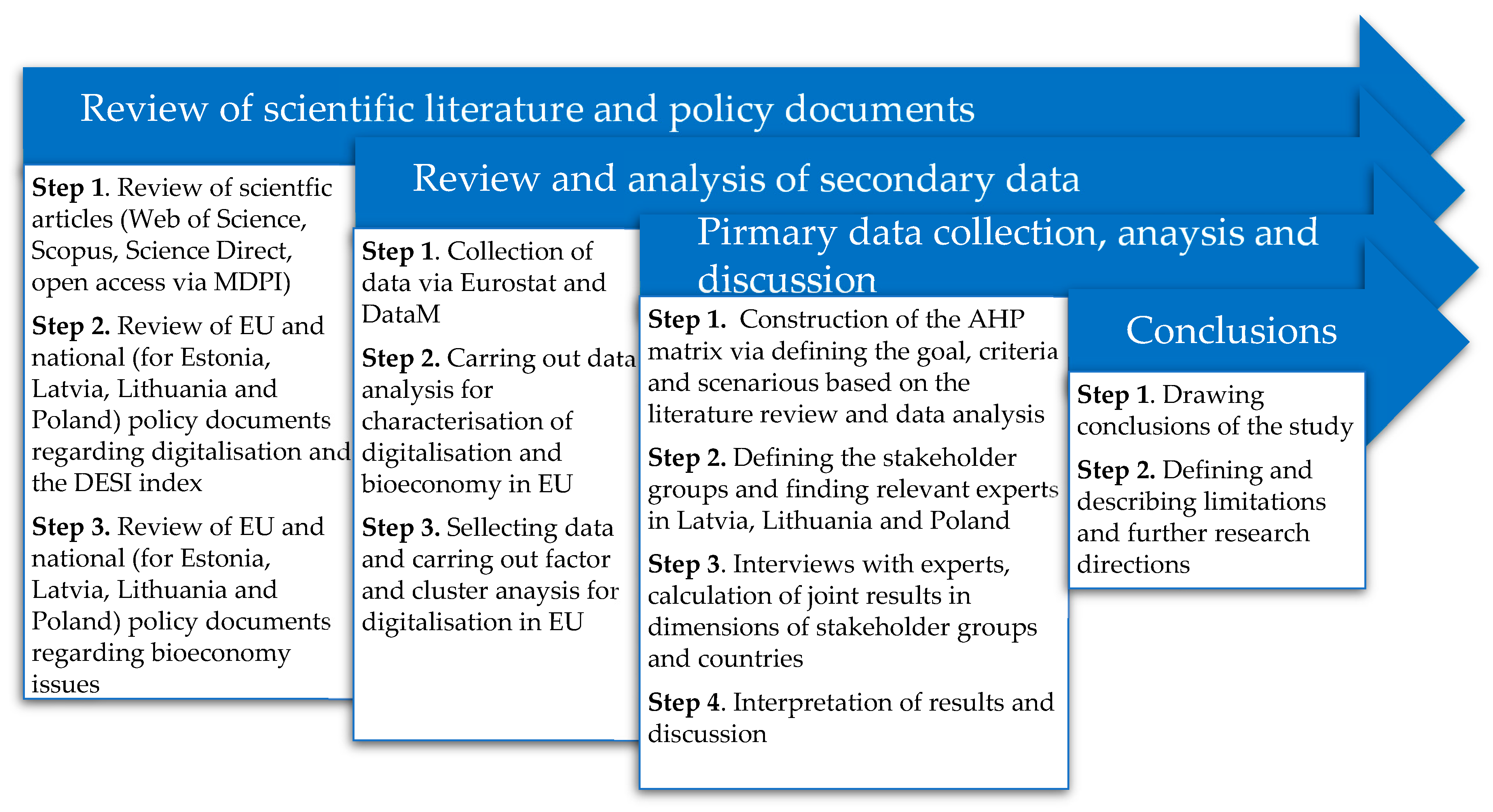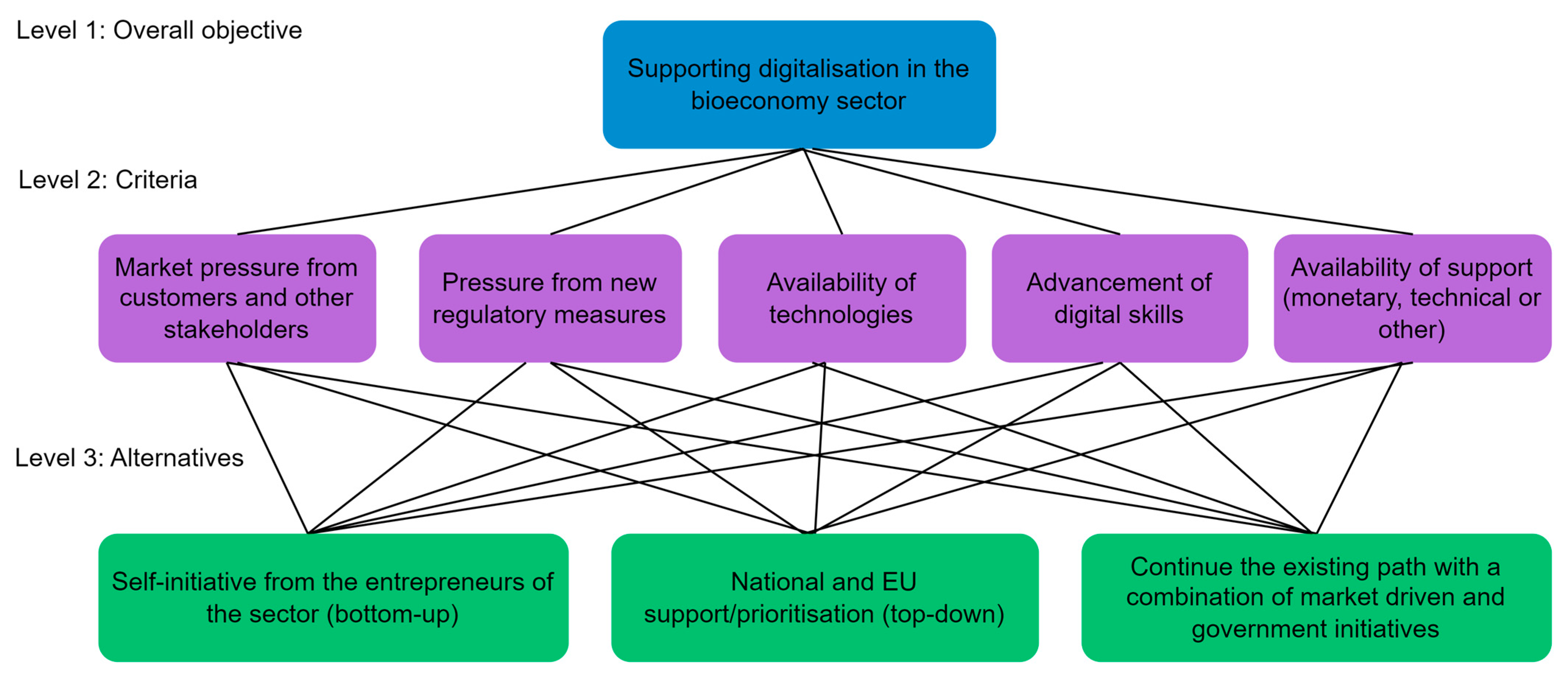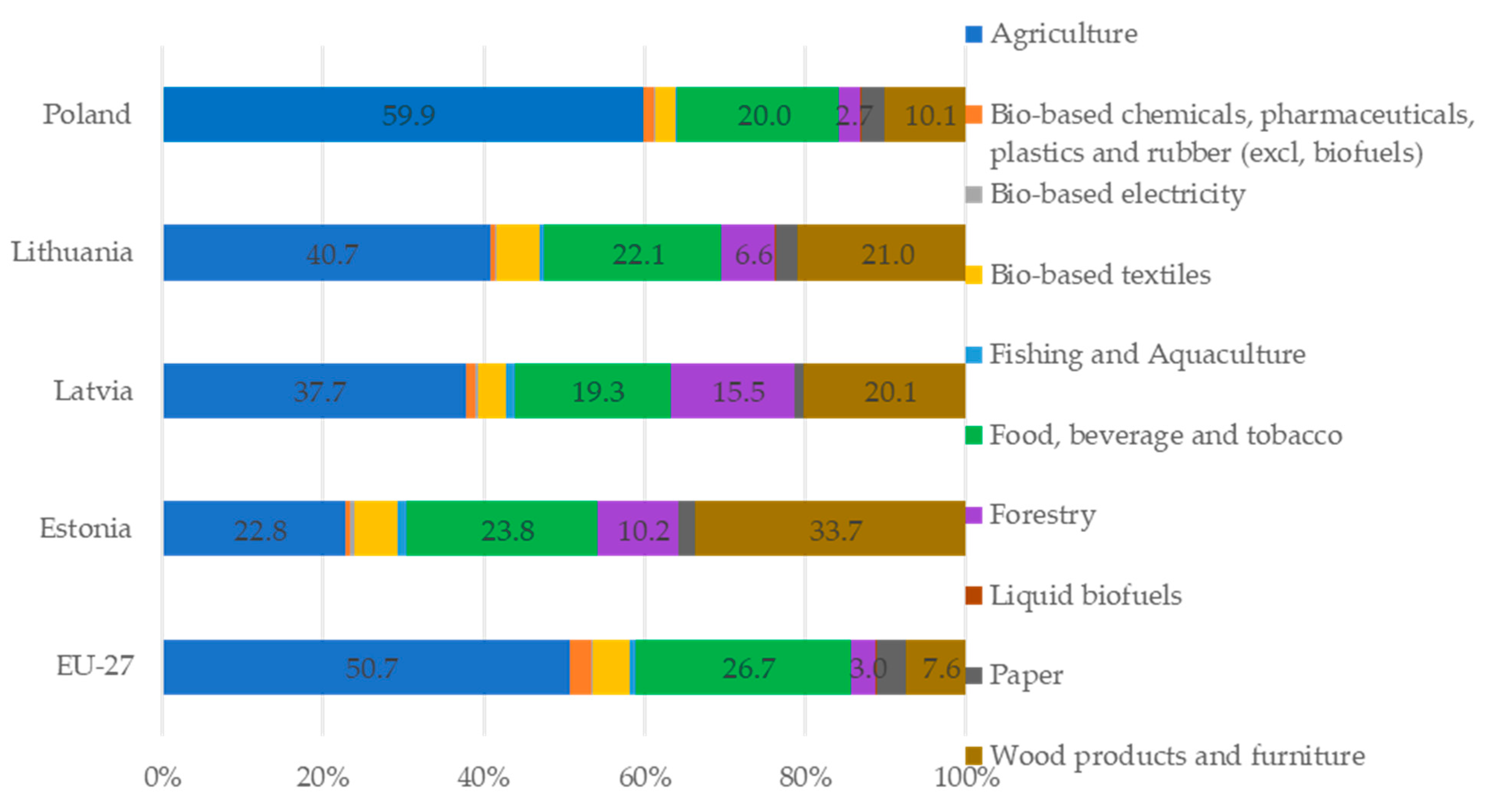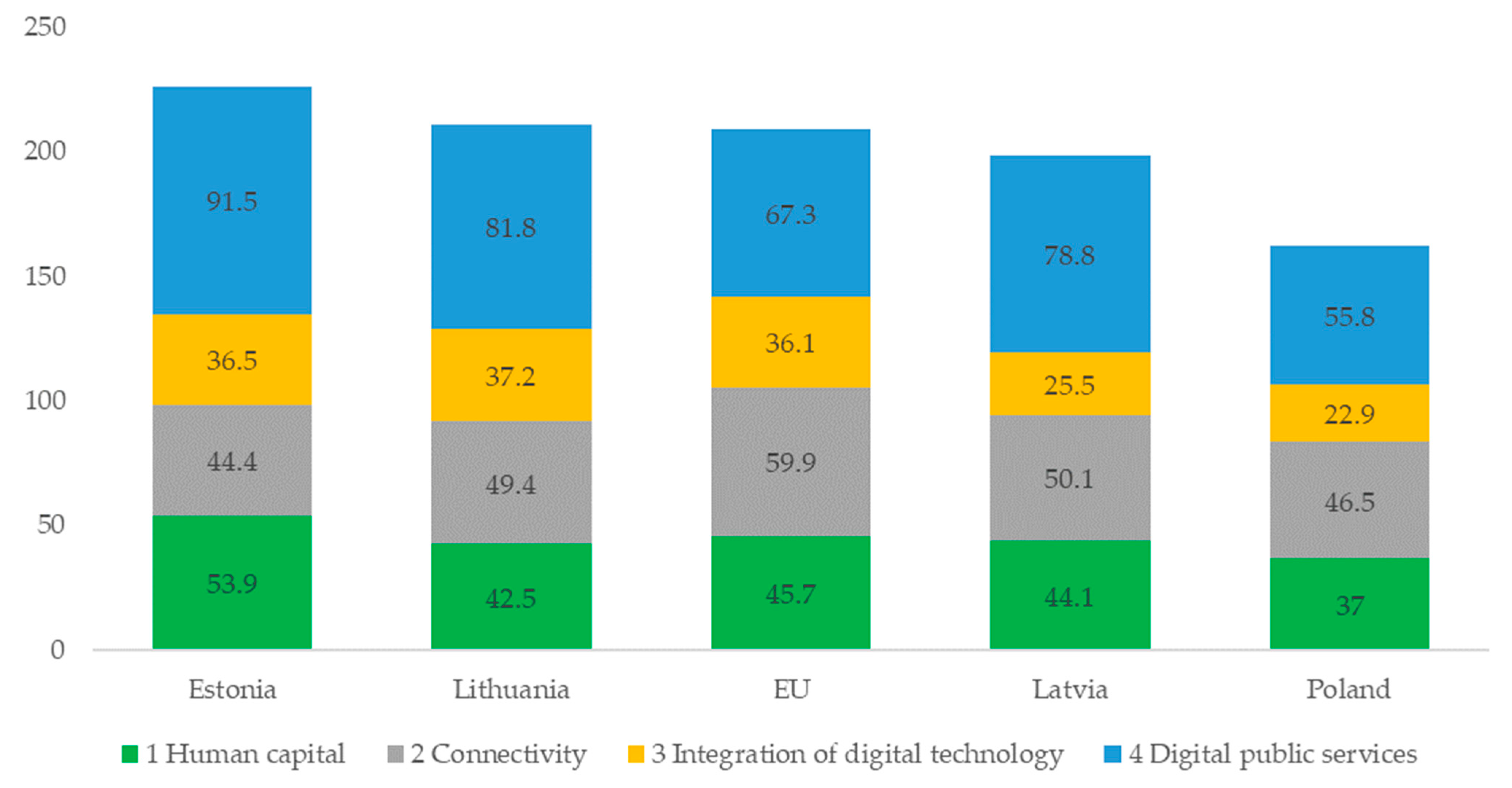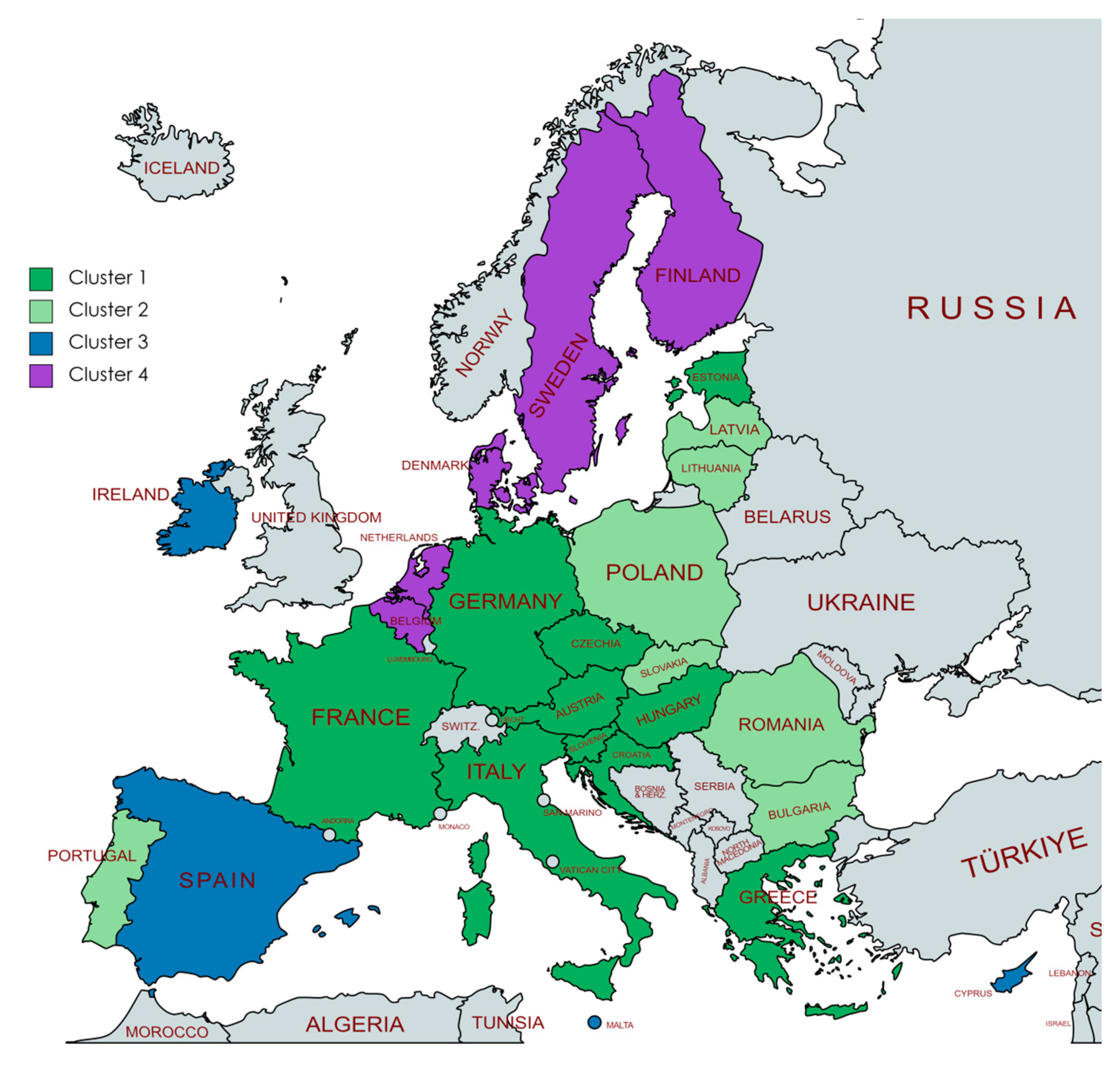3.1. Bioeconomy in the European Union
The bioeconomy is a concept that appeared in the strategic documents of the European Union (EU) at the beginning of the new century (see
Table 3). It has been adopted by individual member states and their regions in response to the scientific and research domain, the economic sector, and public authorities to the challenges of modernity [
32]. The main challenges related to this are the growing world population, the accelerating depletion of certain resources, especially non-renewable ones, including fossil energy sources, the growing pressure of the industrial sector on the environment, and adverse climate change [
33].
The current interest in bioeconomy issues stems from several challenges faced by the global economy, which include sustainable management of natural resources, sustainable production, improving public health, mitigating the adverse effects of climate change, integrating social and economic development, and global sustainability [
34]. For this reason, the bioeconomy has become an essential area of interest for the European Union and a critical element in the implementation of various policies. In 2012, the concept of bioeconomy development was reflected in the European Union’s Bioeconomy strategy—Innovating for Sustainable Growth. A Bioeconomy for Europe [
33]. In the bioeconomy development program, the European Commission identified several priority goals, the implementation of which would lay the groundwork for the development of a more innovative, resource-efficient, and competitive society, in which ensuring food security would be realized under conditions that protected the natural environment, while at the same time enabling the use of renewable resources in other industrial sectors [
33]. The goals formulated in this way indicated the need to support the development, in EU countries, of the production of renewable biological resources and the conversion of these resources and waste streams into higher value-added products, such as food, feed, bio-based products, and bioenergy.
Table 3.
Selected definition of bioeconomy.
Table 3.
Selected definition of bioeconomy.
| Reference | Defining Methods of Bioeconomy |
|---|
| Enriquez, Martinez [35] | All economic actions obtained from scientific and/or research activity focused on understanding mechanisms and processes at the genetic/molecular levels and their application to industrial processes. |
| EC DG Research [36] | All production systems involving biophysical and biochemical processes, and thus encompassing all the life sciences and related general technologies necessary to produce useful products; biotechnology applications in agriculture and industry, such as biorefineries, bioenergy and biochemicals, are an essential part of the biobased economy; it also includes new forms of land and sea utilisation (such as those that improve ecosystem services and other public goods), as well as the use of materials currently considered waste. |
| OECD [37] | Converting life science knowledge into new, sustainable, eco-efficient, and competitive products. |
| BECOTEPS [38] | Refers to the sustainable production and conversion of biomass into a range of food, health, fibre, and industrial products and energy. |
| EC DG Research [39] | An economy utilising biological resources from the land and sea and waste, including food wastes, as inputs to industry and energy production cover bio-based processes for green industries. |
| EC DG Research [33] | Bioeconomy includes the production of renewable biological resources and the transformation of these resources and waste streams into value-added products such as food, feed, bio-based products and bioenergy. The bioeconomy is based on life sciences, agronomy, ecology, food and social sciences, biotechnology, nanotechnology, information and communication technologies (ICT), and engineering. It encompasses the sectors of agriculture, forestry, fisheries, food, pulp and paper production, and parts of chemical, biotechnological and energy industries. |
| McCormick, Kautto [40] | An economy where the basic building blocks for materials, chemicals and energy are derived from renewable biological resources, such as plant and animal sources. |
| GBS [41] | Production, utilisation, and regeneration of resources, including connected knowledge, outcome of research, and innovation, to provide information, products, processes, and services within and across all economic sectors to reach sustainable economic development. |
| Birner [42] | The knowledge-based production and utilisation of biological resources, innovative biological processes and principles to sustainably provide goods and services across all economic sectors |
| CBE JU [43] | The bioeconomy is an emerging—and rapidly growing—sector that will play a key role in the sustainable production of renewable biological resources from both land and aquatic environments. |
The main aim was to maximize its contribution to the 2030 Agenda, the Sustainable Development Goals (SDGs), and the Paris Agreement. This update is also related to the new European policy priorities, all of which emphasise the significance of a sustainable, circular bioeconomy to meet their goals. More specifically, they are included in the revised Industrial Policy Strategy, the Circular Economy Action Plan, and the Communication on Accelerating Innovation in Clean Energy. The reviewed Strategy for Sustainable Bioeconomy in Europe endorses the five goals, but in the context of the revised policy, proposes three key priorities, namely: Strengthening and scaling up the bio-based sectors, unlocking investments and markets; Rapidly deploying local bioeconomies across Europe, and Understanding the ecological boundaries of the bioeconomy [
46].
According to the JRC report Trends in the Bioeconomy, as of 10 December 2022 of the EU27 countries had national bioeconomy strategies (i.e., Austria, France, Finland, Germany, Ireland, Italy, Latvia, The Netherlands, Portugal, Spain) and seven countries were in the process of development of their national strategies (i.e., Czechia, Croatia, Hungary, Lithuania, Poland, Sweden, and Slovakia) [
47]. It should also be pointed out that currently, there are three macro-regional bioeconomy initiatives engaging governmental authorities in Europe. These include BIOEAST—Central-Eastern European Initiative for Knowledge-based Agriculture Aquaculture and Forestry in the Bioeconomy (
https://www.norden.org/en/bioeconomy (accessed on 23 May 2023)), Nordic bioeconomy (
https://www.matis.is/media/utgafa/actions_for_sustainable_bioeconomy_in_the_west_nordic_region.pdf (accessed on 23 May 2023)), and Bioeconomy in the Baltic Sea Region (
http://bsrbioeconomy.net/ (accessed on 25 May 2023)).
In 2019, the bioeconomy created more than 17.42 million jobs (plus one million new green jobs anticipated by 2030) and more than EUR 2.346 trillion in annual turnovers in the EU.
According to the 2019 data, the largest share (68%) of the EU bioeconomy turnover was recorded by agriculture and food production (
Table 4 and
Figure 3). In 2019, 49.3% of the turnover of the EU bioeconomy came from the food, beverage, and tobacco industries, i.e., €967 billion in food production, €153,67 billion in beverage production and €36.16 billion in tobacco production, which was €1.157 trillion in total. The second largest share in the EU bioeconomy turnover was generated by Agriculture—€437 billion (18.63%). The next sectors are as follows: bio-based chemical sector (8.39%), paper production industry (8.04%), and production of wood products and furniture (7.53%).
A comparable situation can be observed when analysing value added in the bioeconomy: in 2019, the total value added was €57 billion, the majority of which was generated by food, beverage and tobacco production (€237.46 billion) and agriculture (€192.8 billion). Each sector generated about a third of the total value added in the bioeconomy. Within this group, the highest value added was generated by the bio-based chemicals sector (€64.52 billion), production of wood products and furniture (€49.6 billion), and paper industry (€48.21 billion).
The evaluation of turnover of the bioeconomy sectors in Estonia, Latvia, Lithuania, and Poland indicates variability (
Figure 3), from €7.58 billion in Estonia (0.32% of the turnover of the bioeconomy sector in EU27) to €146.88 billion in Poland (6.26% of the turnover of the bioeconomy sector in EU27).
Analysing the structure of turnover of the bioeconomy in Lithuania and Poland in 2019, it can be seen that the largest part of turnover is accounted for by food, beverage, and tobacco production (respectively 36.2%, i.e., €3.2 billion; 52.9%, i.e., €28.9 billion) followed by agriculture, wood production and furniture. Simultaneously, in Estonia and Latvia, the largest part of turnover came from the production of wood products and furniture (35%, i.e., €2.7 billion; 28.4%, i.e., €2.3 billion, respectively (notably from wood products), followed by food, beverage and tobacco production and agriculture. A relatively significant share of the turnover structure was also accounted for by forestry. The analysis of the value added in the bioeconomy of the studied countries has shown a similar structure.
The analysis of the employment in the bioeconomy sectors (
Table 5,
Figure 4) has suggested the prevalence of agriculture and food production, which together accounted for 78% of total employment in the bioeconomy. In 2019, 17.42 million people were employed in the bioeconomy of the EU27; specifically, 8.83 million were employed in agriculture and 4.66—in food production.
Employment analysis in the bioeconomy sectors in Estonia, Latvia, Lithuania, and Poland has indicated variability (
Figure 4), from 61.7 thousand people employed in Estonia (0.3% of people employed in the bioeconomy sector in EU27) to 2.3 million people employed in Poland (14% of people employed in bioeconomy sector in EU27). Latvia, Lithuania, and Poland recorded the highest share of employment in the agricultural sector, while in Estonia, the largest number of people employed was in wood products and furniture. In Latvia and Lithuania, it could also be noticed that a large share of people working in the bioeconomy sector was employed in the production of wood products and furniture (20.1%; 21%). The second sector registering high employment was food production (respectively, Estonia—23.8%, Latvia—19.3%, Lithuania—22.1%, and Poland 20%).
3.2. Digitalisation in the Baltic States and Poland
Digitization in the EU is reflected in the Digital Economy and Society Index (DESI), calculated annually and showing the progress of digital transformation achieved in EU member countries. The newest DESI report of 2022 relied on the data of 2020, i.e., after the introduction of the pandemic-related restrictions (
Figure 5) [
48].
During the COVID-19 pandemic, the member states were advancing their digitalisation efforts. Nonetheless, they continue to struggle to close the gaps in digital skills, the digital transformation of SMEs, and the rollout of advanced 5G networks.
The EU has made significant resources available to support digital transformation by allocating EUR 127 billion to digital reforms and investments under the National Recovery and Resilience Plans. This presented an opportunity to accelerate digitalisation, make the Union more resilient, and reduce external dependencies through reforms and investments. On average, the member states allocated 26% of their funds subject to allocation under the Recovery and Resilience Facility (RRF) to digital transformation, exceeding the mandatory 20% threshold. Austria, Germany, Luxembourg, Ireland, and Lithuania are the countries that have chosen to invest more than 30% of their RRF allocation into digital technology.
Estonia ranked 9th, and Lithuania ranked 14th of 27 EU member states in the 2022 edition of the DEXI. Both countries performed well and ranked above the EU average by the majority of indicators, except for connectivity in the case of Estonia and connectivity and human capital in the case of Lithuania. Estonia’s performance growth was slower than in other countries with similar DESI results. Between 2017 and 2022, Estonia raised its score by about 6.5% each year, compared to the EU average of 7.5%. Lithuania was close to the average in many indicators, but the country’s progress has slowed over the past five years, and catching up with the most digitalised EU countries has not been as fast as it could have been. Lithuania still has prospects to improve the digital skills of its population and to invest in retraining and upskilling its workforce, as it presently ranks 20th in the DESI human capital dimension.
Meanwhile, Latvia and Poland ranked lower than the average of the 27 EU member countries in DESI 2022 (17th and 24th, respectively). Latvia’s DESI index has grown at a slower rate than in the majority of other EU countries over the past few years, while Poland’s DESI index has grown slightly more than the EU average. Still, neither country has yet managed to catch up with other member states.
3.4. Evaluation of Scenarios and Criteria for Increasing the Level of Digitalisation in the Bioeconomy Sector
As mentioned in
Section 2, covering the research methods, the structure of the AHP for this study consists of 3 levels. Level 1 is the overall objective to assess the scenarios and criteria for supporting digitalisation in the bioeconomy sector. Level 2, or the criteria level, consists of 5 criteria:
1. Market pressure for customers and other stakeholders;
2. Pressure from new regulatory measures;
3. Availability of technologies;
4. Advancement of digital skills;
5. Availability of support (monetary, technical, or other).
Level 3 involves three alternatives or scenarios:
1. Self-initiative from the enterprises of the sector (bottom-up scenario);
2. National and EU support/political prioritisation of digitalisation (top-down scenario);
3. A scenario that implies a continuation of the existing path with a combination of market-driven and government initiatives.
According to the obtained results (
Figure 7 and
Figure 8), the Lithuanian and Polish experts prioritised the criteria promoting scenario No. 1, which implies self-initiative from the enterprises of the sector (bottom-up). Meanwhile, experts from Latvia considered scenario No. 2 –national and EU support for digitalisation and prioritization of digitalisation—to be the best scenario. Based on Estonia’s example, digitalisation can be an efficient driver for the economy, while strategic prioritisation followed by sufficient support instruments can have a positive effect on digital transformation and overall economic growth.
The evaluation of criteria (
Figure 9 and
Figure 10) by comparing them between the countries indicates that all countries have considered market pressure from customers to be the leading driver for change in digitalisation in the bioeconomy sector, followed by the availability of technologies in Latvia (and advancement of digital skills in Poland) and regulatory measures in Lithuania. Overall, the availability of technologies is considered important among all three countries and assessed equally, regulatory measures are considered more important in Latvia and Lithuania. Meanwhile, the Polish experts gave it less emphasis while rating all other criteria higher.
